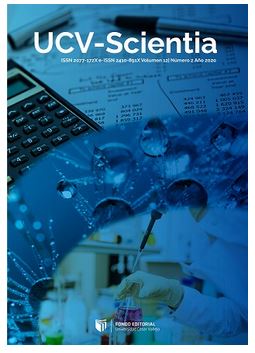Impact of Digital Technology on Reading Comprehension
DOI:
https://doi.org/10.18050/revucv-scientia.v16n1a5Keywords:
digital technology, reading comprehension, digital divide, educational qualityAbstract
Currently, school teaching focuses considerably on strengthening reading comprehension, given its crucial role in learning various academic disciplines; However, it is essential to recognize that improving this skill is not achieved solely by the desire to do so; rather, it requires the implementation of specific strategies; as well as being able to use technology, which is important but in some cases is impossible due to access. By virtue of this need, the present study focuses on examining a set of official documents that in recent years introduced digital technologies in Peru, with the objective of evaluating their importance, access, coverage or contribution to a major problem in our country. country, such as reading comprehension. This study is based on a document analysis approach and ethnographic educational research of an exploratory, descriptive and bibliographic type in certain sources and documentaries. The findings revealed that in our country digital technology is being used comprehensively, standing out as a fundamental resource to enhance reading comprehension; However, there is still a wide digital gap that limits the work to be done, causing certain inequalities and failing to prioritize the right to education. It is concluded that the situation of reading comprehension in Peru is still critical, despite the fact that some progress is observed in the latest PISA 2022 evaluation. However, the country persists in its efforts to promote and reinforce the habit of reading. from home, through the support of digital technology. This approach aims to turn reading into an interactive experience, providing personalized, attractive, colorful and rich in stories of discovery digital platforms for both children and their families; as well as trying to encourage reading by holding different contests at the national level integrating the use of ICTs.
References
Baretta, L., Braga Tomitch, L. M., Lim, V. K., & Waldie, K. E. (2012). Investigating reading comprehension through EEG. Ilha do Desterro: A Journal of English Language, Literatures in English and Cultural Studies, (63), 69-99. http://www.redalyc.org/articulo.oa?id=478348701004
Calderón Arévalo, M. Y., Flores Mejía, G. S., Ruiz Pérez, A., & Castillo Olsson, S. E. (2022). Gamificación en la compresión lectora de los estudiantes en tiempos de pandemia en Perú. Revista De Ciencias Sociales, 28, 63-74. https://doi.org/10.31876/rcs.v28i.38145
Chura Condori, R. M., Valero Ancco, V. N., & Calderon Quino, K. M. (2022). Siete niveles lingüísticos como estrategia para mejorar la comprensión lectora. COMUNI@CCION: Revista de Investigación en Comunicación y Desarrollo, 13(1), 42-52. https://doi.org/10.33595/2226-1478.13.1.590
Díaz-Vásquez, O. A., (2023). Las pruebas PISA de la OCDE: una revisión a las tendencias de la literatura. PANORAMA, 17(33), 1-33, https://doi.org/10.15765/pnrm.v17i33.4112
Duche Pérez, A. B., Montesinos Chávez, M. C., Medina Rivas Plata, A., & Siza Montoya, C. H. (2022). Comprensión lectora inferencial en estudiantes universitarios. Revista de Ciencias Sociales (Ve), Esp. 28(6), 181-198. https://www.redalyc.org/journal/280/28073815013/html/
Fonseca, L. , Migliardo, G. , Simian, M. , Olmos, R. y León, J. A. (2019). Estrategias para Mejorar la Comprensión Lectora: Impacto de un Programa de Intervención en Español. Psicología Educativa, 25, 91 - 99. https://doi.org/10.5093/psed2019a1
Gómez-Arteta, Indira, & Escobar-Mamani, Fortunato. (2021). Educación virtual en tiempos de pandemia: Incremento de la desigualdad social en el Perú. Revista Chakiñan de Ciencias Sociales y Humanidades, (15), 152-165. https://doi.org/10.37135/chk.002.15.10
Huanca-Arohuanca, J. W., Asqui Manzano, M. L., Mamani Jilaja, D., Mamani-Coaquira, H., Huayanca Medina, P. C., & Charaja Cutipa, F. (2021). Habilidades lingüísticas y comprensión lectora en la oquedad del siglo XXI: Una mirada a la Institución Educativa Politécnica de Puno – Perú. Horizontes. Revista de Investigación en Ciencias de la Educación, 5(18), 537-555. https://doi.org/10.33996/revistahorizontes.v5i18.194
INEI (2022). Acceso a internet por teléfono celular subió de 86,8% a 89,3%. Perú. https://m.inei.gob.pe/prensa/noticias/acceso-a-internet-por-telefono-celular-subio-de-868-a-893-14084/
IPT (2019). Sostenibilidad para todos. Perú. ttps://aniversario5.ipt.pe/revistadigital_052024.pdf
López, M. L. (2023). ¿Es la tecnología un verdadero aliado de la educación digital en el Perú?:Una mirada desde un programa de lectura digital. https://tesis.pucp.edu.pe/repositorio/bitstream/handle/20.500.12404/25843/LOP EZ_ESTRADA_MARIA_ELISA_LC.pdf?sequence=1&isAllowed=y
Mendoza-Zambrano, D. M., Tirado-Morueta, R., & Marín-Gutiérrez, I. (2017). Niveles de acceso a Internet de los estudiantes del bachillerato en Ecuador. Chasqui. Revista Latinoamericana de Comunicación, 134. 391-410. https://www.redalyc.org/journal/160/16057382023/
MINEDU (2022). Resultados prueba PISA 2022. http://umc.minedu.gob.pe/resultadospisa2022/?fbclid=IwAR1d_RufGPHb9XtrB KhSUbqImzeaAfDWLtsQhwV2SMBZ5gI_8jdWfcDl8v8
MINEDU (2023). Concurso Nacional de Comprensión Lectora "El Perú Lee". de https://www.gob.pe/institucion/minedu/campa%C3%B1as/29357-concursonacionalde-comprension-lectora-el-peru-lee
MINEDU (2023). Bases del Concurso Nacional de Comprensión Lectora “El Perú Lee”. https://www.gob.pe/institucion/minedu/campa%C3%B1as/29357-concurso-naci onal-de-comprension-lectora-el-peru-lee
OCDE (2022). Results PISA (Volume I and II) - Country Notes: Perú. Recuperado: https://www.oecd.org/en/publications/2023/11/pisa-2022-results-volume-i-and-ii-country-notes_2fca04b9/peru_21d86e8b.html
Pérez-Camarero, J., Martínez-Gallego, R., Guzmán, J. F., & Crespo, M. (2022). Formación en línea de los entrenadores deportivos: revisión bibliográfica. Apuntes Educación Física y Deportes, 38(147), 26-35. https://doi.org/10.5672/apunts.2014-0983.es.(2022/1).147.03
Quispe Aquise, J., Bautista Quispe, J. A., Arce Coaquira, E. L., Sillo Sosa, J., & Jara Rodríguez, F. (2023). Gestión educativa y competencia digital de los docentes de las instituciones educativas públicas de Puerto Maldonado. Revista Universidad y Sociedad, 15(2), 217-224. https://rus.ucf.edu.cu/index.php/rus/article/view/3622/3563
Sunkel, G., Trucco, D. & Espejo, A. (2013). La integración de las tecnologías digitales en las escuelas de América Latina y el Caribe, una mirada multidimensional. https://www.cepal.org/es/publicaciones/21681-la-integracion-tecnologias-digitales-escuelas-america-latina-caribe-mirada
Telefónica del Perú (2019) Internet Para Todos. Lima - Perú. https://telefonica.com.pe/sostenibilidad-e-innovacion/internet-para-todos/
UNESCO (2020).Teacher’s Guide onEarly Grade Reading Instruction. https://unesdoc.unesco.org/ark:/48223/pf0000373170
UNESCO (2023). Tecnología en la educación: ¿una herramienta en los términos de quién? https://doi.org/10.54676/IDQE8212
Worldreader (2023). CreceLee aims to promote better and more equitable learning for all children in Peru. https://www.worldreader.org/
Downloads
Published
How to Cite
Issue
Section
License

This work is licensed under a Creative Commons Attribution 4.0 International License.
- Share — copy and redistribute the material in any medium or format
- Adapt — remix, transform, and build upon the material.
- The licensor cannot revoke these freedoms as long as you follow the license terms.
Under the following terms:
-
Attribution — You must give appropriate credit, provide a link to the license, and indicate if changes were made. You may do so in any reasonable manner, but not in any way that suggests the licensor endorses you or your use.
- No additional restrictions — You may not apply legal terms or technological measures that legally restrict others from doing anything the license permits.













